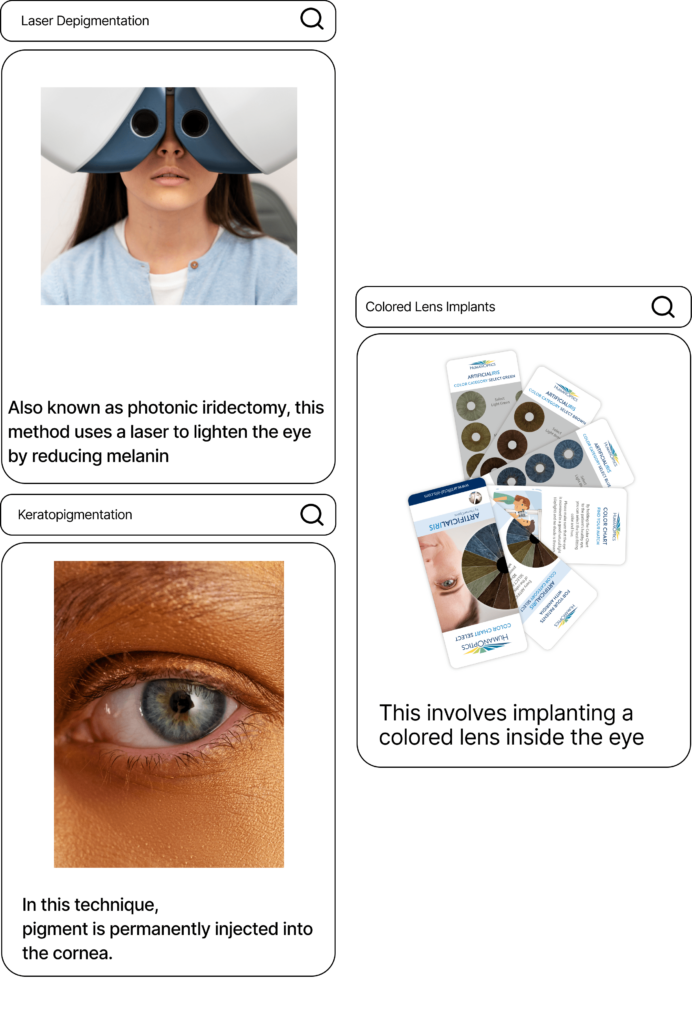Essential Tips for Preparing for an Eye Color Change Surgery
Home / Essential Tips for Preparing for an Eye Color Change Surgery


Essential Tips for Preparing for an Eye Color Change Surgery
In recent years, eye color change procedures have become increasingly popular as a cosmetic solution, allowing people to achieve a new eye color. However, due to the precision required in these procedures, thorough preparation is essential for ensuring both safety and satisfaction with the results. If you are considering undergoing this type of surgery, several important factors must be considered — from choosing the most suitable technique for your goals and health to consulting with experienced medical professionals. Here, we’ll provide you with essential guidance to help you prepare optimally for this experience, allowing you to make informed decisions that bring you closer to your desired outcome with minimal risk.
Key Preparations Before Eye Color Change Surgery
The road to successful eye color change surgery begins with careful preparation, which helps in achieving desired results and minimizing potential risks. First and foremost, selecting the right technique is crucial. There are three primary methods to consider:
Colored Lens Implants:
This involves implanting a colored lens inside the eye.
Laser Depigmentation:
Also known as photonic iridectomy, this method uses a laser to lighten the eye by reducing melanin.
Keratopigmentation:
In this technique, pigment is permanently injected into the cornea.


Each technique has its advantages and potential risks, and the best option for you will depend on your health status and what you hope to achieve from the procedure. For a successful outcome, a thorough consultation with a medical professional is essential to help you decide on the most suitable method.
It is also recommended to have a comprehensive eye examination to ensure there are no underlying issues or conditions that could interfere with the procedure or lead to complications afterward. Tests such as measuring eye pressure, checking corneal thickness, and assessing the retina’s health are vital. Additionally, make sure to inform your doctor about any chronic conditions, such as diabetes or high blood pressure, as these can affect recovery or the results of the surgery.
In the days leading up to the surgery, follow your doctor’s instructions closely. These might include avoiding contact lens use for a week before the procedure to allow the eyes to breathe naturally and removing any false lashes, as these can interfere with the surgery. Additionally, you should refrain from using any chemical products near the eyes and avoid smoking to support faster healing and better outcomes. When selecting your desired eye color, take the time to choose wisely. Ask your center to provide a simulation of potential colors to ensure you choose the most suitable and flattering option for your features. Careful consideration at this stage will help you feel more confident about your decision.
Having realistic expectations is also crucial. Eye color change is a cosmetic procedure that can take time to adjust to, and understanding the steps of the recovery process and the follow-up requirements will boost your confidence and peace of mind during this journey.

Choosing the Right Doctor for Eye Color Change
Selecting the right doctor is one of the most important steps in ensuring the success and safety of an eye color change procedure. Since these surgeries require a high level of skill and experience, your chosen doctor should ideally be a specialist in ophthalmic surgery, with specific experience in eye color change methods such as keratopigmentation, laser depigmentation, or colored lens implants. A specialist with relevant expertise is better equipped to anticipate and address potential challenges and risks associated with each technique.
Furthermore, ensure that the doctor operates in a reputable and accredited medical facility that adheres to the highest standards of quality and safety. Facilities with advanced technologies, like the VisuMax laser for keratopigmentation, and rigorous sterilization procedures reduce the risk of complications, such as infections, while enhancing the overall quality of care.
Choosing a highly qualified and trusted doctor will not only provide you with a sense of confidence and comfort but also increase your likelihood of achieving satisfying and lasting results from the procedure.
Necessary Medical Tests Before Surgery
Medical tests are a crucial step in determining your eligibility for eye color change surgery. A thorough eye examination is necessary to ensure the health and readiness of your eyes for the procedure. This examination often includes checking the strength and thickness of the cornea, especially if the chosen technique involves keratopigmentation, which requires precise injection of pigment into the cornea’s outer layers. Eye pressure measurements are also essential to rule out any risk factors for complications during or after surgery.
In addition to eye-specific tests, your doctor may request general health assessments, such as blood sugar and blood pressure tests, and review your medical history to confirm that you don’t have any chronic conditions that could affect your recovery or the procedure’s outcomes. These assessments help the doctor recommend the safest and most effective technique for you, ensuring your results are both secure and satisfying.

Pre-Surgery Consultations: What to Expect
Consulting with your doctor before an eye color change surgery is one of the most informative and essential steps in the preparation process. During these sessions, your doctor will evaluate your overall health and examine your eyes to confirm there are no underlying conditions that might impact the procedure. This stage is also your opportunity to discuss the available options for eye color change, such as keratopigmentation, colored lens implants, or laser depigmentation. Your doctor can help you weigh the pros and cons of each option based on your expectations and unique health circumstances.
During these consultations, the doctor will explain each procedure in detail, including the stages of the surgery, the expected duration, potential risks, and post-surgery recovery steps. Understanding the factors that might influence the final outcome such as your natural eye color and general eye health is also critical. Furthermore, discussing your expectations and aligning them with realistic outcomes ensures that you’re well-prepared for the results. Your doctor should also address any questions or concerns you may have, creating a foundation of trust and preparedness.


Understanding the Risks and Potential Complications
Being aware of the possible risks and complications is essential before deciding on any surgical procedure, and eye color change surgeries are no exception. While these procedures are generally safe when performed by qualified and experienced professionals, some risks are involved. One of the most common risks is infection, which can occur if strict sterilization protocols aren’t followed or if the post-operative care isn’t handled correctly. Other potential complications include inflammation, sensitivity to light, or unintended color changes.
Each technique comes with its own set of risks. For instance, laser depigmentation can lead to uneven pigmentation, and keratopigmentation may require a longer healing period. Discuss these possibilities with your doctor and ensure you understand the measures in place to reduce them. Having realistic expectations and knowing what to anticipate will empower you to make a more informed decision about the surgery.
Post-Surgery Care and Recovery Tips
The recovery process after an eye color change surgery varies depending on the technique used and your body’s natural healing abilities. Generally, it’s crucial to follow all post-operative instructions provided by your doctor to aid recovery and achieve the best results. Your doctor may advise using eye drops to prevent infection or alleviate dryness, avoiding direct sunlight or bright lights, and refraining from activities that strain the eyes.
If you experience any unusual symptoms, such as increased sensitivity or prolonged redness, inform your doctor promptly. Attending all follow-up appointments is essential to monitor your healing progress and detect any early signs of complications, should they arise. Patience is key, as it may take weeks or even months to see the full effects of the surgery, particularly with techniques like laser depigmentation that require gradual changes.


Conclusion: Preparing for a Successful Eye Color Change
Deciding to undergo an eye color change procedure is a significant choice, blending elements of personal aesthetics with medical considerations. From selecting the most suitable method and performing the necessary pre-surgery preparations to choosing a qualified doctor and understanding the associated risks, each step is vital to a positive outcome. By following these essential tips and maintaining close communication with your healthcare provider, you can look forward to achieving your desired eye color with minimized risks and optimized results.
Get Your Free Consultation or Book Your Appointment Now
Lorem ipsum dolor sit amet, consec tetur adipiscing elit. Fusce vitae commodo ipsum, eu ullam corper magna. Nam non posuere lacus, eget viverra massa sed magna ligula.



